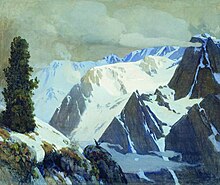
Back Burkhanismo AN Burxancılıq Azerbaijani Бурханизм BXR بورخانییەت CKB Burjanismo Spanish Burkhanismi Finnish Bourkhanisme French Burhanizmus Hungarian Burkhanisme ID Burkhanismo Italian
This article needs additional citations for verification. (January 2008) |
 Khan-Altai (1912) by Grigory Gurkin | |
| Total population | |
|---|---|
| up to 81% of Altai[1][2] | |
| Founder | |
| Chet Chelpan • Chugul Sarok Chandyk | |
| Regions with significant populations | |
| Altai Republic | |
| Religions | |
| Ethnic religion • Tengrism | |
| Languages | |
| Altai | |
| Related ethnic groups | |
| Altaians |
| Part of a series on |
| Tengrism |
|---|
 |
| A Central Asian–Eurasian Steppe and partly Siberian–East Asian religion |
| Supreme deity |
| Other deities/spirits |
| Movements |
| Related movements |
| People |
| Priests |
| Scriptures |
| Holy places |
| Toponyms |
| Related conceptions |
|
|
Burkhanism or Ak Jang (Altay: Ак јаҥ, romanized: Ak çaņ, lit. 'the White Faith') is an indigenist new religious movement that flourished among the Altai people of Russia's Altai Republic between 1904 and the 1930s. The Russian Empire was suspicious of the movement's potential to stir up native unrest and perhaps involve outside powers.[3] The Soviet Union ultimately suppressed it for fear of its potential to unify Siberian Turkic peoples under a common nationalism.[citation needed]
Originally millenarian, charismatic and anti-shamanic, the Burkhanist movement gradually lost most of these qualities—becoming increasingly routine, institutionalized (around a hierarchy of oral epic singers) and accommodating itself to the pre-existing Altaian folk religion. It exists today in several revival forms.[4][5]
On the whole, the Burkhanist movement was shown to be a syncretistic phenomenon combining elements of ancient pre-shamanist, shamanist, Tibetan Buddhist and Eastern Orthodox Christian beliefs. According to a professor of Tomsk State University Liudmila Sherstova, it emerged in response to the needs of a new people—the Altai-kizhi or Altaians who sought to distinguish themselves from the neighboring and related tribes and for whom Burkhanism became a religious form of their ethnic identity.[6]
- ^ Bourdeaux & Filatov 2006, p. 105.
- ^ Cite error: The named reference
regnumwas invoked but never defined (see the help page). - ^ The detailed account of the events of 1904-1906 is available in Russian. Sherstova (1986, 2010), Бурханизм [Burkhanism], Tomsk State University Press. Chapter 2.
- ^ Filatov 2001.
- ^ Halemba 2003.
- ^ Sherstova, Burhanism, Chapter 1, 2, 3. Almost three hundred pages of the book leave little doubt about the validity of this conclusion by Sherstova made in 1977-1986.